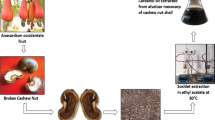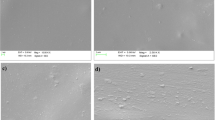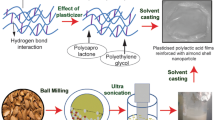Abstract
The intention of this work is to study the impact of inclusion of Cashew nut shell powder (CNS) in the Poly vinylalcohol (PVA) based films. CNS is a biowaste material chosen as a particulate reinforcement, and the biodegradable polymer PVA is made as a matrix material. The films with various weight proportion was fabricated through solution casting method and characterized using FTIR, XRD, morphological examinations, mechanical and thermal property analysis, antibacterial evaluation, and degradation tests. Compared to films lacking essential oil, the biodegradable films showed significant enhancements in mechanical properties, with tensile strength increasing to 22 MPa (a 130% increase), tensile modulus increasing to 264 MPa, and elongation decreasing by 24.5%. However, the addition of essential oil significantly improved thermal stability, with the initiation of degradation showing at a significantly higher temperature of 215 °C, representing a significant 43% increase. The antimicrobial testing revealed a significant 93% reduction in bacterial growth, demonstrating CNS's potency as an antibacterial agent. These findings highlight the possibility of combining CNS with PVA to fabricate biocomposite films with higher biodegradability and antibacterial characteristics, along with higher tensile strength and thermal stability, confirming their viability for eco-friendly packaging materials and other sustainable applications.
Graphical Abstract










Similar content being viewed by others
Data availability
Any data related to this manuscript can be made available on request.
References
Rathinavel S, Senthilkumar TS, Saravanakumar SS, et al (2023) Development and analysis of environmentally friendly biocomposite films with pomegranate peel as filler for conventional applications. Biom. Conv. Bioref. https://doi.org/10.1007/s13399-023-04658-z.
Awad, M.A., Hendi, A.A., Ortashi, K.M.O., Elradi, D.F.A., Eisa, N.E., Al-lahieb, L.A., Al-otiby, S.M., Merghani, N.M., Awad, A.A.G.: Int. J. Phys. Sci. 9, 34–40 (2014)
Rathinavel, S., Saravanakumar, S.S.: Development and Analysis of Silver Nano Particle Influenced PVA/Natural Particulate Hybrid Composites with Thermo-Mechanical Properties. J. Polym. Environ. 29, 1894–1907 (2021). https://doi.org/10.1007/s10924-020-01999-y
Davis, G., Song, J.H.: Biodegradable packaging based on raw materials from crops and their impact on waste management. Ind. Crops and Prod. 23(2), 147–161 (2006). https://doi.org/10.1016/j.indcrop.2005.05.004
Gross, R.A.: Biodegradable Polymers for the Environment. Science 297(5582), 803–807 (2002). https://doi.org/10.1126/science.297.5582.803
Rathinavel, S., Saravanakumar, S.S.: Synthesis of Silver Nanoparticles Through Orange Peel Powder for Antibacterial Composite Filler Applications. J. Polym. Environ. 30, 1407–1414 (2022). https://doi.org/10.1007/s10924-021-02276-2
Panou, Andreas, Karabagias, Ioannis Konstantinos: Biodegradable Packaging Materials for Foods Preservation: Sources, Advantages, Limitations, and Future Perspectives. Coatings 13(7), 1176 (2023). https://doi.org/10.3390/coatings13071176
Li, M., Sun, Y., Feng, D., et al.: Thermally conductive polyvinyl alcohol composite films via introducing hetero-structured MXene@silver fillers. Nano Res. 16, 7820–7828 (2023). https://doi.org/10.1007/s12274-023-5594-1
Silva, G.G.D., Sobral, P.J.A., Carvalho, R.A., et al.: Biodegradable Films Based on Blends of Gelatin and Poly (Vinyl Alcohol): Effect of PVA Type or Concentration on Some Physical Properties of Films. J. Polym. Environ. 16, 276–285 (2008). https://doi.org/10.1007/s10924-008-0112-9
Hajji, S., Chaker, A., Jridi, M., et al.: Structural analysis, and antioxidant and antibacterial properties of chitosan-poly (vinyl alcohol) biodegradable films. Environ. Sci. Pollut. Res. 23, 15310–15320 (2016). https://doi.org/10.1007/s11356-016-6699-9
Suganthi, S., Vignesh, S., Kalyana Sundar, J., et al.: Fabrication of PVA polymer films with improved antibacterial activity by fine-tuning via organic acids for food packaging applications. Appl Water Sci 10, 100 (2020). https://doi.org/10.1007/s13201-020-1162-y
Emran, M.Y. et al. (2023). Biowaste Materials for Advanced Biodegradable Packaging Technology. In: Ali, G.A.M., Makhlouf, A.S.H. (eds) Handbook of Biodegradable Materials. Springer, Cham. https://doi.org/10.1007/978-3-031-09710-2_46
Ismail, H., Zaaba, N.F.: Effect of Additives on Properties of Polyvinyl Alcohol (PVA)/Tapioca Starch Biodegradable Films. Polym Plast Technol Eng 50(12), 1214–1219 (2011). https://doi.org/10.1080/03602559.2011.566241
Rathinavel, S., Saravanakumar, S.S.: Development and Analysis of Poly Vinyl Alcohol/Orange peel powder biocomposite films. J. Nat. Fibers. 18(12), 2045–2054 (2020)
Balavairavan, B., Saravanakumar, S.S.: Characterization of Ecofriendly Poly (Vinyl Alcohol) and Green Banana Peel Filler (GBPF) Reinforced Bio-Films. J. Polym. Environ. 29, 2756–2771 (2021). https://doi.org/10.1007/s10924-021-02056-y
S. Tripathi; G.K. Mehrotra; P.K. Dutta (2009). Physicochemical and bioactivity of cross-linked chitosan–PVA film for food packaging applications. , 45(4), 0–376. doi:https://doi.org/10.1016/j.ijbiomac.2009.07.006
G. Davis, J.H. Song: Biodegradable packaging based on raw materials from crops and their impact on waste management. 23 147-161 (2006)https://doi.org/10.1016/j.indcrop.2005.05.004
N.H. Mutha, M. Patel, V. Premnath: Plastics materials flow analysis for India. 47 222-244 (2006) https://doi.org/10.1016/j.resconrec.2005.09.003
S. Gupta, K. Mohan, R. Prasad, S. Gupta: Solid waste management in India : options and opportunities. 24 137-154 (1998)
Soni, B., Mahmoud, B., Chang, S., El-giar, E.M., Barbary, E.: Physicochemical, antimicrobial and antioxidant properties of chitosan / TEMPO biocomposite packaging fi lms. Food Packag. Shelf Life 17(June), 73–79 (2018). https://doi.org/10.1016/j.fpsl.2018.06.001
Kicińska-Jakubowska, Anna, Bogacz, Edyta, Zimniewska, Ma.łgorzata: Review of Natural Fibers Part I—Vegetable Fibers. J Nat Fib 9(3), 150–167 (2012). https://doi.org/10.1080/15440478.2012.703370
Divakaran, D., Suyambulingam, I., Gapsari, F., Vijay, R., Ayyappan, V., & Siengchin, S: Isolation and characterization of microcrystalline cellulose from an agro-waste tamarind (Tamarindus indica) seeds and its suitability investigation for biofilm formulation. Intl. J. Biol. Macromol. (2024) https://doi.org/10.1016/j.ijbiomac.2023.127687.
Dineshkumar, J., Jesudas, T.: Hybrid polymer matrix development using cashew nut shell liquid as an additive into epoxy resin. J. Chin. Inst. Eng. 46(4), 380–388 (2023)
Ike, D.C., Ibezim-Ezeani, M.U., Akaranta, O.: Cashew nutshell liquid and its derivatives in oil field applications: an update. Green Chem. Lett. Rev. 14(4), 620–633 (2021)
Nuithitikul, K., Phromrak, R., Saengngoen, W.: Utilization of chemically treated cashew-nut shell as potential adsorbent for removal of Pb(II) ions from aqueous solution. Sci. Rep. 10, 3343 (2020). https://doi.org/10.1038/s41598-020-60161-9
Singaravelu, D. L., Vijay, R., & Filip, P: Influence of various cashew friction dusts on the fade and recovery characteristics of non-asbestos copper free brake friction composites. Wear. (2019) https://doi.org/10.1016/j.wear.2018.12.036
Sadanand, V., Rajini, N., Varada Rajulu, A., Satyanarayana, B.: Effect of Sunlight on the Preparation and Properties of Cellulose/Silver Nanoparticle Composite Films by in Situ Method Using Ocimum Sanctum Leaf Extract as a Reducing Agent. Int. J. Polym. Anal. Charact. 23(4), 313–320 (2018). https://doi.org/10.1080/1023666X.2018.1440915
Saravanakumar, S.S., Kumaravel, A., Nagarajan, T., Sudhakar, P., Baskaran, R.: Characterization of a Novel Natural Cellulosic Fiber from Prosopis Juliflora Bark. Carbohyd. Polym. 92(2), 1928–1933 (2013). https://doi.org/10.1016/j.carbpol.2012.11.064
Santhanam, K., Kumaravel, A., Saravanakumar, S.S., Arthanarieswaran, V.P.: Characterization of New Natural Cellulosic Fiber From Ipomoea Staphylinaplant. Int. J. Polym. Anal. Charact. 21(3), 267–274 (2016). https://doi.org/10.1080/1023666X.2016.1147654
Soni, B., Mahmoud, B., Chang, S., et al.: Physicochemical, antimicrobial and antioxidant properties of chitosan/TEMPO biocomposite packaging films. Food Pack. and Shelf Life 17(June), 73–79 (2018). https://doi.org/10.1016/j.fpsl.2018.06.001
Mathew, S., Snigdha, S., Mathew, J., Radhakrishnan, E.K.: Poly(vinyl alcohol): Montmorillonite: Boiled rice water (starch) blend film reinforced with silver nanoparticles; characterization and antibacterial properties. Appl. Clay Sci. 161, 464–473 (2018). https://doi.org/10.1016/j.clay.2018.05.009
Palai, B., Sarangi, S.K., Mohapatra, S.S.: Characterization of silver nano-particle coated Eichhornia crassipes fiber for antibacterial applications. J. Nat. Fibers 19, 1828–1836 (2022). https://doi.org/10.1080/15440478.2020.1788492
Lee, S.W., Phillips, K.S., Gu, H., Kazemzadeh-Narbat, M., Ren, D.: How microbes read the map: Effects of implant topography on bacterial adhesion and biofilm formation. Biomaterials 268, 120595 (2021). https://doi.org/10.1016/j.biomaterials.2020.120595
Rajini, N., Alavudeen, A., Siengchin, S., Rajulu, V., Ayrilmis, N.: Development and analysis of completely biodegradable cellulose/banana peel powder composite films. J Nat Fibers (2019). https://doi.org/10.1080/15440478.2019.1612811
Senthilkumar, P., Yaswant, G., Kavitha, S., et al.: Preparation and characterization of hybrid chitosan-silver nanoparticles (Chi-Ag NPs); A potential antibacterial agent. Int. J. Biol. Macromol. 141, 290–298 (2019)
Suteewong, T., Wongpreecha, J., Polpanich, D., et al.: PMMA particles coated with chitosan-silver nanoparticles as a dual antibacterial modifier for natural rubber latex films. Coll. Sur. B: Biointerfaces 174, 544–552 (2018)
Gupta, M.K., Manimaran, P., Suresha, B., et al.: Investigation of mechanical and dynamic mechanical properties of novel Acacia arabica fiber polyester hybrid composites. Polym. Compos. (2022). https://doi.org/10.1002/pc.26569
Indira Devi, M.P., Nallamuthu, N., Rajini, N., et al.: Tensile, thermal, and antibacterial characterization of composites of cellulose/ modified Pennisetum purpureum natural fibers with in situ generated copper nanoparticles. Int. J. Poly. Anal. Charact. 23(6), 502–508 (2018). https://doi.org/10.1080/1023666X.2018.1485201
Cano, A.I., Cháfer, M., Chiralt, A., González-Martínez, C.: Physical and microstructural properties of biodegradable films based on pea starch and PVA. J. Food Eng. 167, 59–64 (2015)
Baskaran, P.G., Kathiresan, M., Senthamaraikannan, P., Saravana Kumar, S.: Characterization of new natural cellulosic fiber from the bark of dichrostachys cinerea. J Nat Fibers 15, 1–7 (2017). https://doi.org/10.1080/15440478.2017.1304314
Prithivirajan, R., Narayanasamy, P., Al-Dhabi, N.A., et al.: Characterization of Musa Paradisiaca L. cellulosic natural fibers from agro-discarded blossom petal waste. J Nat Fibers 17, 1640–1653 (2020). https://doi.org/10.1080/15440478.2019.1588826
Shanmugasundaram, N., Rajendran, I., Ramkumar, T.: Characterization of untreated and alkali treated new cellulosic fiber from an Areca palm leaf stalk as potential reinforcement in polymer composites. Carbohydr. Polym. 195, 566–575 (2018). https://doi.org/10.1016/j.carbpol.2018.04.127
Bhanu, Priya, Vinod Kumar, Gupta, Deepak, Pathania, Amar Singh, Singha: Synthesis, characterization and antibacterial activity of biodegradable starch/PVA composite films reinforced with cellulosic fibre. Carbohyd. Polym. 109, 171–179 (2014). https://doi.org/10.1016/j.carbpol.2014.03.044
Kumar, Deepak; Kumar, Pramendra; Pandey, Jyoti (2018). Binary grafted chitosan film: Synthesis, characterization, antibacterial activity and prospects for food packaging. International Journal of Biological Macromolecules, S0141813017342599–. doi:https://doi.org/10.1016/j.ijbiomac.2018.04.084
Rayna Bryaskova, Daniela Pencheva, Girish M. Kale, Umesh Lad, T. Kantardjiev : Synthesis, characterisation and antibacterial activity of PVA/TEOS/Ag-Np hybrid thin films. , 349(1), 77–85 (2010). https://doi.org/10.1016/j.jcis.2010.04.091
Thiagamani, S.M.K., Rajini, N., Siengchin, S.: Influence of silver nanoparticles on the mechanical, thermal and antimicrobial properties of cellulose-based hybrid nanocomposites. Compos. Part B. Engineering 165, 516–525 (2019)
Funding
Not Applicable.
Author information
Authors and Affiliations
Contributions
All authors contributed equally to this manuscript.
Corresponding author
Ethics declarations
Ethical Approval
Not Applicable.
Competing interests
The authors declare no competing interests.
Additional information
Publisher's Note
Springer Nature remains neutral with regard to jurisdictional claims in published maps and institutional affiliations.
Rights and permissions
Springer Nature or its licensor (e.g. a society or other partner) holds exclusive rights to this article under a publishing agreement with the author(s) or other rightsholder(s); author self-archiving of the accepted manuscript version of this article is solely governed by the terms of such publishing agreement and applicable law.
About this article
Cite this article
Mahanta, G.K., Joardar, H. Study on the Impact of Bio Waste Cashew Nut Shell Powder in the Polyvinyl Alcohol Bio Films. Waste Biomass Valor (2024). https://doi.org/10.1007/s12649-024-02576-3
Received:
Accepted:
Published:
DOI: https://doi.org/10.1007/s12649-024-02576-3




